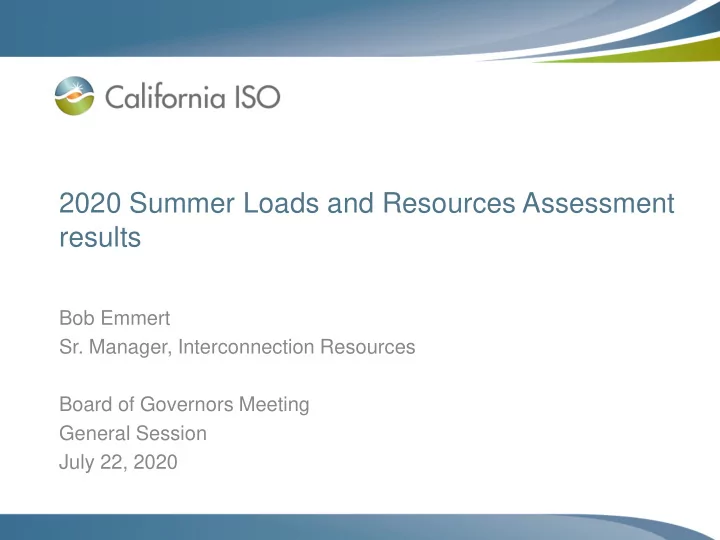

2020 Summer Loads and Resources Assessment results Bob Emmert Sr. Manager, Interconnection Resources Board of Governors Meeting General Session July 22, 2020
Summer Assessment 2020 • The Summer Assessment process uses a production simulation model that runs 2,000 simulations of varying levels of weather driven load and renewable generation. • Report for 2020 represents results from 2 cases. 1. Base case: import limit set to capture most historical import levels. 2. Moderate sensitivity case: import limit set more conservative levels. • 2020 load forecast relatively unchanged from 2019. • CA hydro conditions are below normal – close to 2018 conditions. – Snowpack peaked at 63% of average, reservoirs at 101% of average. – The Northwest hydro reservoirs projected to be 95% of average. • Generation additions minus retirements equals 1,432 MW. ‒ Effective load carrying capability increase for September is 38 MW. Page 2
General Conclusions • ISO projects overall adequate supply despite a low hydro year. – Resource adequacy levels are similar to the summer of 2018. – Tight supply conditions are more likely to occur in late summer when hydropower declines to its summer low levels, particularly in September when solar decreases as well. • Rooftop solar continues to offset load growth and has pushed the system peak to evening hours when solar is no longer available. • Reliance on imports increases during the late summer when the impacts of below-normal hydro conditions will be more pronounced. Page 3
Impacts to loads due to COVID-19 • Too many unknowns exist to produce a viable and meaningful COVID-19 load impact scenario. • The ISO has experienced load reductions of 5 to 8 percent on weekdays, and 1 to 4 percent on weekends, with the largest reductions occurring over the morning peak hours. • 2020 summer air conditioning loads have started materialize and to date show no decrease in evening peak demands. • While the ISO does recognize there are likely to be lasting effects from COVID-19 throughout the 2020 summer period, there is not enough data to forecast the magnitude and hourly profile of those impacts. Page 4
On-peak net import cap nomograms for base case and conservative imports sensitivity Page 5
Import limit impacts the probability of a system capacity shortfall Probability of ISO system capacity shortfall Result Base Case Sensitivity Case Stage 2 3.7% 10.6% Stage 3 1.1% 4.7% Unserved energy 0.2% 1.6% Page 6
Base case: minimum unloaded capacity margins 3.7% 1.1% Page 7
Conservative import sensitivity: minimum unloaded capacity margins 10.6% 4.7% Page 8
Base case demonstrates highest risk when solar is unavailable Minimum Unloaded Capacity Margin ISO Solar generation 1388 1400 Solar generation 1200 No. of MUCM occurrences 1000 800 600 400 262 171 200 77 66 17 18 1 0 6:00 7:00 8:00 9:00 10:00 11:00 12:00 13:00 14:00 15:00 16:00 17:00 18:00 19:00 20:00 21:00 22:00 Time Page 9
Conservative case confirms highest risk when solar is unavailable Minimum Unloaded Capacity Margin ISO Solar generation 1401 1400 Solar generation 1200 No. of MUCM occurrences 1000 800 600 400 280 155 200 74 55 19 15 1 0 6:00 7:00 8:00 9:00 10:00 11:00 12:00 13:00 14:00 15:00 16:00 17:00 18:00 19:00 20:00 21:00 22:00 Time Page 10
Conclusions • Compared to our projections in 2019, this summer poses somewhat increased risk of conditions that could result in operating reserve shortfalls. • Overall, adequacy levels are similar to the summer of 2018, with similar hydro conditions. – Adequate imports may be critical in late summer when the impacts of below-normal hydro conditions are more pronounced. – A late summer heat wave, especially if wide spread and impacting imports, would be particularly challenging. • Adequacy levels are most challenged in the post-solar window, as reductions in the gas fleet have not yet been offset by sufficient storage to offset the loss of capacity available in that window. Page 11
Recommend
More recommend